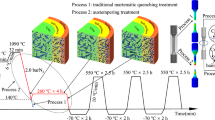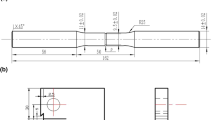Abstract
Fatigue tests were conducted for a modified ausformed and tempered JIS-SCM440 low-alloy (denoted as AF) steel with tensile strengths of 1600 and 2000 MPa, respectively, and were compared with normally quenched and tempered (QT) steel. The 1600 MPa-class modified ausformed steel (AF1600) developed no fish-eye fractures and a fatigue limit of 920 MPa, whereas normally quenched steel (QT1600) developed fish-eye fractures and showed a lower fatigue limit of 840 MPa. The 2000 MPa-class modified ausformed steel (AF2000) achieved a high fatigue limit of 1010 MPa, but developed fish-eye fractures. The fatigue limit of normally quenched steel (QT2000) was 840 MPa. Results of fatigue tests at 20 kHz up to 109 and 1010 cycles agreed with the fatigue limits for QT1600 and QT2000, respectively. The fracture sites of fish-eye fractures in QT1600 were Al2O3 and TiN inclusions, and those in AF2000 and QT2000 were Al2O3 and TiN inclusions and internal facets. Fracture surfaces of QT2000 that broke at over 107 cycles had large, clearly identifiable optically dark areas (ODAs). The AF2000 showed no fractures over 107 cycles, and the authors could not conclude whether the fracture surface of the specimens broken at around 5 × 106 cycles had ODAs. The fact that long-life fatigue failure over 107 cycles did not occur in AF2000 showed that ODAs did not form in this steel, since ODAs developed in proportion to cycle number and became large and clearly identifiable at over 107 cycles. Their incidence was quantitatively demonstrated by modified Stress amplitude vs Number of cycles to failure (S-N) diagram analysis. The modified S-N curve for AF2000, in which the specimens were assumed to have no ODAs, showed good agreement with that for QT2000, in which ODAs were assumed to be formed, especially at over 107 cycles.
Similar content being viewed by others

References
Y. Murakami: Metal Fatigue: Effects of Small Defects and Nonmetallic Inclusions, Yokendo, Tokyo, 1993.
S. Nishijima and K. Kanazawa: Fatigue Fract. Eng. Mater. Struct., 1999, vol. 22, pp. 601–07.
K.J. Miller and W.J. O’Donnell: Fatigue Fract. Eng. Mater. Struct., 1999, vol. 22, pp. 545–57.
NRIM Fatigue Data Sheet Nos. 2,3,4,8,9,10,16,17,24,25,26,59,60,63, National Research Institute for Metals, Tokyo, 1978–90.
T. Ohshiro, T. Ikeda, H. Matsuyama, S. Okushima, Y. Oki, and N. Ibaraki: Kobelco Technol. Rev., 1987, vol. 2, pp. 36–40.
Y. Murakami, T. Nomoto, and T. Ueda: Fatigue Fract. Eng. Mater. Struct., 1999, vol. 22, pp. 581–90.
Y. Murakami, T. Nomoto, T. Ueda, and Y. Murakami: Fatigue Fract. Eng. Mater. Struct., 2000, vol. 23, pp. 893–902.
Y. Murakami, T. Nomoto, T. Ueda, and Y. Murakami: Fat. Fract. Eng. Mater. Struct., 2000, vol. 23, pp. 903–10.
Y. Murakami, N.N. Yokoyama, and K. Takai: Mater. Sci. Res. Int. (JSMS), Special Technical Publication 1, 2001, pp. 29–34.
Y. Murakami, M. Takada, and T. Toriyama: Int. J. Fatigue, 1998, vol. 16(9), pp. 661–67.
T. Abe, Y. Furuya, and S. Matsuoka: Trans. Jpn. Soc. Mech. Eng., 2001, Ser. A, vol. 67(664), pp. 1988–95 (in Japanese)
T. Sawai, Y. Kimura, K. Tsuzaki, E. Takeuchi, and S. Matsuoka: Trans. Jpn. Soc. of Mech. Eng., 2002, Ser. A, vol. 68(665), pp. 49–56 (in Japanese).
T. Wu and T. Bathias: ASTM STP 1231, ASTM, Philadelphia, PA, 1994.
S.E. Stanzl-Tschegg: Ultrasonic Fatigue—Fatigue 96, Pergamon Press, Elmsford, NJ, 1996, pp. 1886–87.
H. Ishi, K. Yamanaka, and K. Tohgo: Mater. Sci. Res. Int. (JSMS), Special Technical Publication I, 2001, pp. 59–64.
Y. Furuya, S. Matsuoka, T. Abe, and K. Yamaguchi: Scripta Mater., 2002, vol. 46–2, pp. 195–204.
S. Yusa, T. Hara, K. Tsuzaki, and T. Takahashi: Proc. Int. Workshop on the Innovative Structural Materials for Infrastructure in the 21st Century (NRIM), 2000, pp. 195–204.
S. Yusa, K. Tsuzaki, and T. Takahashi: CAMP-ISIJ, 1999, vol. 12, p. 1296.
R.A. Bock and W.M. Justusson: Met. Progr., 1968, vol. 94, pp. 107–12.
M. Hayakawa, T. Hara, S. Matsuoka, and K. Tsuzaki: Mater. Trans. JIM, 2000, vol. 64, pp. 460–66 (in Japanese).
ASTM Standards E45, ASTM, Philadelphia, PA., 1997.
E.J. Gumbel: Statistics of Extremes, Columbia University Press, New York, NY, 1957.
N.M.A. Eid and P.F. Thomason: Acta Mater., 1979, vol. 27, pp. 1239–49.
L.H. Donnel: in Stress Concentration Factors, R.E. Peterson, ed., John Wiley & Sons, New York, NY 1974, p. 223.
Author information
Authors and Affiliations
Rights and permissions
About this article
Cite this article
Furuya, Y., Matsuoka, S. Improvement of gigacycle fatigue properties by modified ausforming in 1600 and 2000 MPA-class low-alloy steels. Metall Mater Trans A 33, 3421–3431 (2002). https://doi.org/10.1007/s11661-002-0329-5
Received:
Issue Date:
DOI: https://doi.org/10.1007/s11661-002-0329-5



